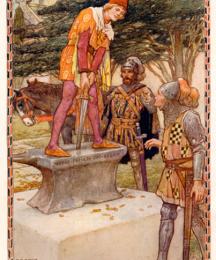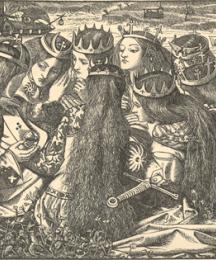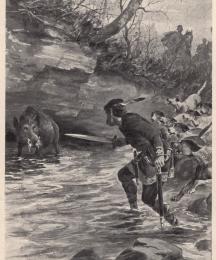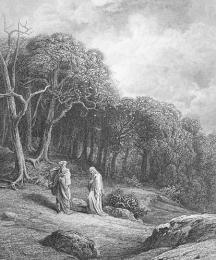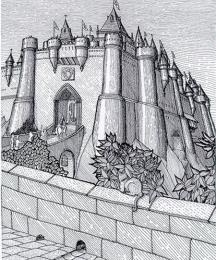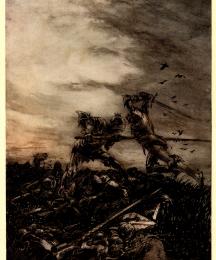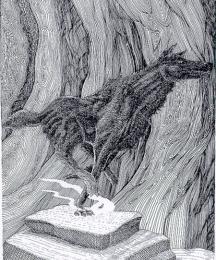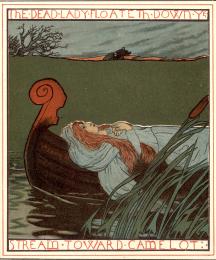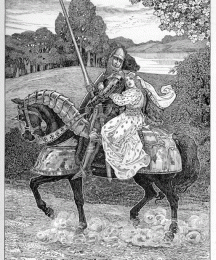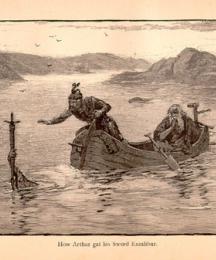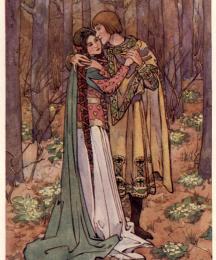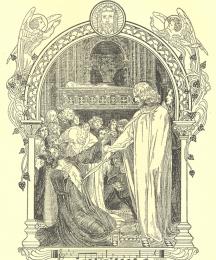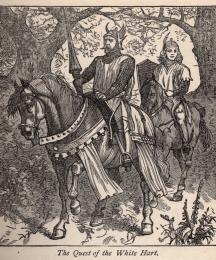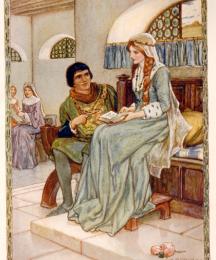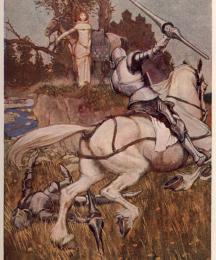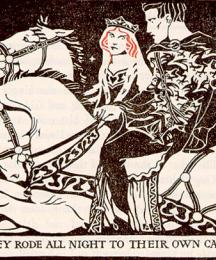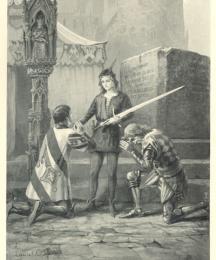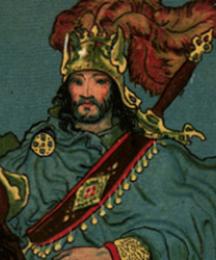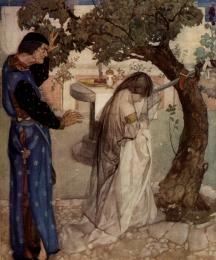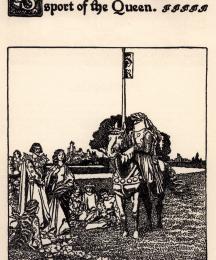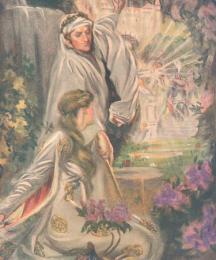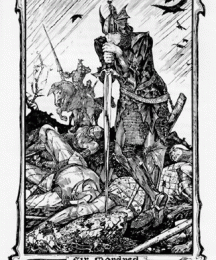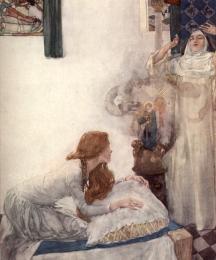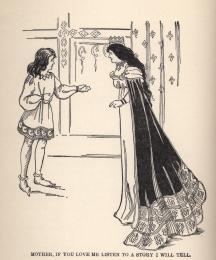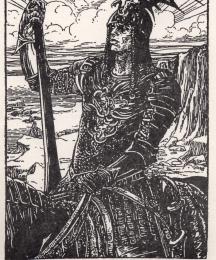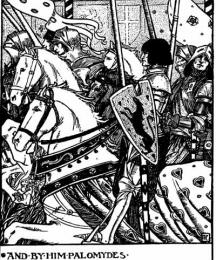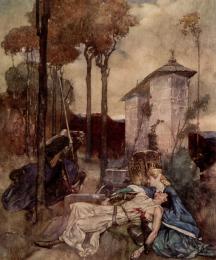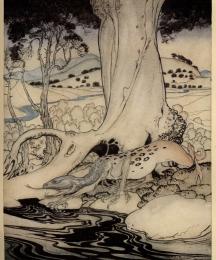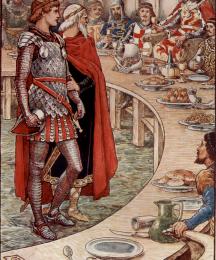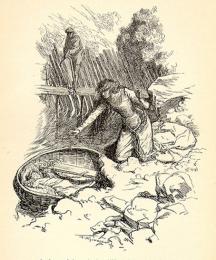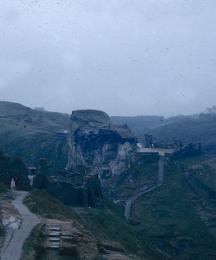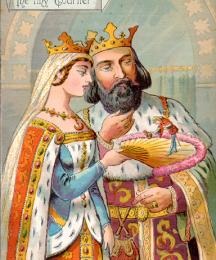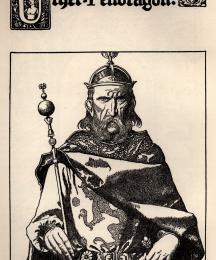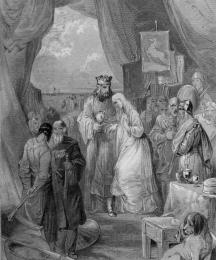Robbins Library Digital Projects Announcement: We are currently working on a large-scale migration of the Robbins Library Digital Projects to a new platform. This migration affects The Camelot Project, The Robin Hood Project, The Crusades Project, The Cinderella Bibliography, and Visualizing Chaucer.
While these resources will remain accessible during the course of migration, they will be static, with reduced functionality. They will not be updated during this time. We anticipate the migration project to be complete by Summer 2025.
If you have any questions or concerns, please contact us directly at robbins@ur.rochester.edu. We appreciate your understanding and patience.
While these resources will remain accessible during the course of migration, they will be static, with reduced functionality. They will not be updated during this time. We anticipate the migration project to be complete by Summer 2025.
If you have any questions or concerns, please contact us directly at robbins@ur.rochester.edu. We appreciate your understanding and patience.
Agravaine is the son of Lot and Morgause and the brother of Gawain. In the Vulgate Lancelot, Agravaine is said to be arrogant and jealous and ready to speak evil words. Although he shows no pity or love, he is a bold knight. In the Vulgate Mort Artu, he tells Arthur that Lancelot loves Guinevere and then traps the lovers in the queen’s room...
King Arthur is the figure at the heart of the Arthurian legends. He is said to be the son of Uther Pendragon and Ygraine of Cornwall. Arthur is a near mythic figure in Celtic stories such as Culhwch and Olwen. In early Latin chronicles he is presented as a military leader, the dux bellorum. In later romance he is presented as a king and emperor....
The Isle of Avalon, most famous as the final resting place of Arthur in many stories and legends, has neither a fixed location nor a fixed description throughout the literary canon of Arthuriana. Geoffrey of Monmouth’s Historia Regum Britanniae (c. 1136) is the oldest extant work including references to Avalon. He calls it Insula Avallonis,...
The story of Balin is recounted in the Old French Suite du Merlin and in Malory's Morte d'Arthur. Balin and Balan are the tragic brothers who, despite their nobility, wind up killing each other. Balin in particular seems cursed by fate. For example, when he offers protection to a knight, he is unable to foresee--or even see--the danger...
In the bestiary tradition, bears are described as having a weak head and strong arms. They give birth to unformed cubs, and the mother forms the cub's body by licking it once it is born (138). These strange attributes are not allegorized, and this lore seems largely absent from the depictions of bears in medieval Arthuriana, where...
Table of Contents
Introduction
Welsh literature and the early chronicle tradition
Twelfth and Thirteenth Century Romance
Fourteenth-Century Romance and Malory
Tennyson’s Idylls of the King
Modern Fiction, Part 1: Bedivere as Storyteller
Modern Fiction, Part 2: Bedivere in Non-Traditional Roles...
The bestiary tradition distinguishes among many varieties of birds, but it attributes some similarities to all of them. They protect their young with their wings and do not fly in direct routes (165-66). One particular type of bird discussed in the bestiary and common in medieval Arthuriana is the hawk, which the bestiary describes as...
Boars are described in the bestiary tradition as fierce creatures (152), though no moral is prescribed to them. While boars serve several functions in medieval Arthuriana, the ferocity ascribed to them in the bestiaries is a consistent element of their appearances in Arthurian works.
Boars appear most frequently in hunts, and, often, they...
Bors is an important character in the Vulgate Cycle and in Malory’s Morte d’Arthur (which does not include the early adventures of Bors but does tell, in an account similar to that in the Vulgate, of Bors’ part in the Grail quest and in the events leading to the fall of Camelot. Bors is the son of King Bors of Gaunes and the...
Broceliande is the forest in which Chrétien’s Yvain begins his adventures by pouring water from a spring on a stone and thus causing a great storm which brings forth the knight Esclados le Ros to defend his land. In the Roman de Rou (begin in 1160), Wace speaks of a similar fountain in Broceliande, a place "about which the...
The bestiary tradition describes bulls as fierce, with hard hides, but provides no specific religious or symbolic significance to them (152-54). However, these descriptors may explain why they are used as a symbol for knights in their appearances in medieval Arthuriana. Bulls appear several times in Arthuriana, but these appearances...
Although Camelot is, for most modern readers, the legendary center of King Arthur's realm, in many medieval texts Arthur holds court at Carleon or some other city. Camelot is first mentioned in line 34 of Chrétien de Troyes's Lancelot; and the name does not appear in all manuscripts of that poem. In the thirteenth-century Vulgate...
Camlan is often said to be the site of Arthur’s final battle. The battle of Camlan is first referred to in the Annales Cambriae (Welsh Annals), where, for the year 539 (given as 537 in most editions), it is described as a battle in which Arthur and Medraut (Mordred) fell; but there is no indication that they were fighting against each other...
The bestiary tradition attributes two major features to cats; first, they attack mice, and second, they have excellent vision (161). These two traits do shape the depictions of cats in medieval art and literature. For example, Joyce Salisbury describes an image in the book of Kells which shows two cats having caught mice nibbling on a...
Berbiolette
In Chretien’s Erec, Erec wears a cloak with fur lining from “strange beasts, which have heads completely blond and necks as black as mulberries, with scarlet backs below, black stomachs, and dark-blue tails. Born in India, such beasts are called berbiolettes… [they] find their only nourishment in fish, cinnamon...
Dagonet, most simply, is King Arthur’s court fool. Also called Daguenet, and often carrying an epithetical surname such as “the Fool” or “the Coward,” the character is perhaps most interesting in that he did not begin his fictional existence as a fool at all. Enid Welsford’s 1935 book, The Fool: His...
According to the bestiary tradition, deer are the enemies of serpents (Clark 134). Deer also migrate, which the tradition glosses to explain that deer are like good Christians, who change their homes from the world to heaven (Clark 135). These moral attributes are generally absent from medieval Arthurian texts, though deer appear quite...
Dinadan comes to prominence in the 13th century in the French Prose Tristan, where he is a foil to those knights who unquestioningly accept the assumptions of chivalry and courtly love. In the 14th-century Italian Tavola Ritonda, Dindano is the cousin of Breus sanz Pietà. He comments on the folly of love but becomes devoted to Tristano....
The second family bestiary tradition comments on the intelligence of dogs, especially their ability to recognize their names, and describes them as very loyal (145). In fact, "often even dogs produced evidential proofs to contradict circumstances of a murder that was committed" (146); they mourn, and they can heal wounds by licking...
Dragons and serpents are very closely related in the bestiary tradition. Dragons are described as the largest of serpents; allegorically, they are like the Devil, who is sometimes presented as a monstrous serpent (194). Vipers, the type of snake given the most attention, are similarly described as wicked and cunning and are associated...
Elaine of Astolat, a character closely related to the Lady of Shalott, is an innocent maiden who falls deeply in love with Sir Lancelot. When he does not return her love, she dies of grief and floats in a barge down the river to Camelot. Elaine’s story is found in important works of literature by authors such as Malory and Tennyson, and she is...
Elaine is the daughter of King Pelles and the mother of Galahad. (The Vulgate Cycle says “she was called Amite though her true name was Helizabel.”) Because she was considered the fairest lady in that country, Elaine was put into a tub of boiling water by Morgan le Fay and the Queen of Northgales and could be freed only by the best...
The bestiary tradition attributes a strange weakness to the elephant; it sleeps standing up, leaning against a tree, because once an elephant falls it is unable to stand back up (128). Elephants are uncommon in medieval Arthuriana, but the myth of an elephant's inability to rise may underlie its appearance in the Alliterative Morte...
Enid and Geraint are the principle figures in the Welsh tale of Geraint the Son of Erbin, to use Lady Charlotte Guest's title, or Geraint and Enid, one of three Welsh stories analogous to romances by Chrétien de Troyes (the others being Owain and Peredur). Chrétien's Erec et Enide, written c. 1170, is his earliest extant...
The Sword in the Stone, sometimes a sword in an anvil, is drawn by Arthur as proof of his birthright and of his nobility. It is both a test and a miraculous sign of his royalty. The sword drawn from the stone is different from the one given to Arthur by the Lady of the Lake. The latter is always referred to as Excalibur; the former is called by...
The "Fair Unknown" is a universally popular folk motif with strong Arthurian connections in which a young man of questionable lineage becomes an integral part of society. Initially appearing in court without an established identity, the Fair Unknown nevertheless boldly demands to be knighted. He tends to be markedly — albeit...
The mysterious Fisher King is a character of the Arthurian tradition, and his story may sound familiar: suffering from wounds, the Fisher King depends for his healing on the successful completion of the hero's task. There are many different versions of the story of the Fisher King, and the character is not represented uniformly in every text....
Foxes are crafty, according to the bestiary tradition; they are able to play dead and lure birds close to capture them (Clark 141). These creatures are thus associated with the Devil, who tricks and ensnares Christians (142). Cunning is the defining attribute of foxes in their few appearances in medieval Arthuriana.
This...
Gaheris is one of Gawain’s brothers, a son of Lot and Morgause. According to the Post-Vulgate Cycle and Malory, Gaheris kills his mother when he finds her in bed with Lamorak. (In T. H. White’s The Once and Future King, it is Agravaine, not Gaheris, who kills his mother.) Gaheris, along with his brother Gareth, is ordered by...
Sir Galahad, the son of Lancelot and Elaine of Corbenic, is best known as the knight who achieves the Holy Grail. When Galahad appears, he is the chief Grail knight; in the French and English traditions, he replaces Perceval in this role. Galahad first appears in the thirteenth-century Vulgate Cycle. The opening part of the Cycle, the Estoire del...
Gareth is the youngest brother of Sir Gawain and the son of Lot and Morgause of Orkney. He plays a significant role in Malory's Morte d'Arthur. Malory's "Tale of Sir Gareth" was apparently created by Malory. It presents Gareth as an exemplar of chivalry who is knighted by and devoted to Sir Lancelot and who acts chivalrously...
Gawain, usually the son of King Lot of Orkney and Arthur's sister Morgause, is one of the most pervasive figures of the Arthurian tradition. He appears in nearly all of the major Arthurian stories, medieval and modern, and plays a central role in many. There are, in fact, more medieval romances devoted to Gawain's exploits than to those of any...
Located in Somerset, Glastonbury is the focal point for a number of legends and stories relating to Arthur and the Grail and is sometimes equated with the Island of Avalon, an association that is bolstered by the fact that the marshy lands of the region made Glastonbury virtually an island in its early history. The site of a medieval abbey and...
Griffins are described in the bestiary tradition as fierce, hostile to horses, and originating in mountainous places, though they are given no moral or spiritual meaning (Clark 127). These elements of the griffin are absent from their depictions in medieval Arthuriana. Gryffins are used as a heraldic device in the Awntyrs of Arthur,...
Guinevere is said to be the daughter of Leodegrance of Cameliard in late medieval romance. In many sources, she marries Arthur and then has a love affair with Lancelot which causes the downfall of Camelot.
The Welsh Triads speak of "Arthur's Three Great Queens," all named Gwenhwyfar (Triad 56) and name Gwenhwyfar as "more...
The Holy Grail is generally considered to be the cup from which Christ drank at the Last Supper and the one used by Joseph of Arimathea to catch his blood as he hung on the cross. This significance, however, was introduced into the Arthurian legends by Robert de Boron in his verse romance Joseph d'Arimathie (sometimes also called Le Roman de l'...
Horses are humanized in the bestiary tradition: "they grieve when conquered, they rejoice when they win" (156), traits that come to the Bestiary tradition via Isidore's writings (158n84). They are praised for their loyalty to their masters, and some, like Alexander the Great's horse Bucephalus, are said to accept no rider...
Hybrid creatures are particularly fascinating in light of new scholarly attention on monsters and monstrosity. While many of these creatures fall into other categories, (such as griffins) or appear throughout medieval Arthuriana (such as the Questing Beast), other hybrids appear only once. Several notable ones are considered here....
Igraine is the wife of Uther Pendragon and the mother of Arthur. Uther falls in love with her when she is married to the Duke of Cornwall, who in some sources is named Gorlois. Uther’s attention to Igraine causes a rift between him and her husband, who secures her in his impregnable castle at Tintagel. Enlisted by Uther to help satisfy his...
One of the most frequently represented characters in Arthurian literature, Kay has never starred in his own romance. He is not a heroic figure: constantly presented as a hot-tempered, sharp-tongued fellow, he is generally abusive to those whom he perceives as weaker than himself. In romances, Kay is tolerated by the rest of the Round Table because...
The Lady of the Lake is an especially ambiguous and shifting character in the Arthurian legends. She accordingly goes by several other names, most of which are variations on Nimue or Vivianne, the latter derived from a Celtic water-goddess. In her initial appearances, however, she is nameless: in the Old French Le Chevalier de la...
In Chrétien’s Erec (ca. 1165), Lancelot is said to be the third best knight after Gawain and Erec, but in Chrétien’s Lancelot (1179-1180), Lancelot becomes the central figure and the lover of Guinevere who is willing to take any risk or to suffer any indignity in service of the queen. According to both Chrétien and...
Lanval or Launfal, while not one of the famous knights like Lancelot, Gawain, Tristan, and Perceval, who dominate medieval romance, was nevertheless internationally known. In the latter half of the twelfth century, Marie de France wrote a Breton lay called Lanval. Breton lay is a term that designates a short verse tale claiming to be based on a...
The bestiary tradition explicitly compares lions to Christ. In Physiologus, for example, two attributes of lions are described that link lions to Christ; first, the lion covers its tracks with its tail to evade hunters just as Christ hid His divine nature from those who did not believe in him. Second, lion cubs are born dead and are...
Mark is King of Cornwall and as brother of Tristan's mother (named Elyzabeth in Malory; Blanscheflur in Gottfried; Blauncheflour in Sir Tristrem) he is Tristan's uncle. Mark appears in early Celtic literature such as the Triad telling the story of Tristan as one of the three powerful swineherds of Britain. In this Triad, "Drystan son...
Meleagant (or Melyag(r)aunce or Melwas) is best known as the wicked knight who abducts Guinevere and is ultimately slain by Lancelot. The earliest form of the name, Melwas, has been interpreted as meaning "prince of death" or "princely youth." The classic account of the abduction story is in Chrétien de Troyes's...
Merlin, Arthur's adviser, prophet and magician, is basically the creation of Geoffrey of Monmouth, who in his twelfth-century History of the Kings of Britain combined the Welsh traditions about a bard and prophet named Myrddin with the story that the ninth-century chronicler Nennius tells about Ambrosius (that he had no human father and that...
Mordred (Modred, Medrawd, or Medraut) has become the quintessential traitorous villain in the Arthurian tradition. According to the majority of texts, he is Arthur's bastard son by his half-sister Morgause, the wife of King Lot. This incestuous begetting, alternately an innocent mistake on the part of both parties, as the French Vulgate...
Like many characters in the Arthurian legends, Morgan le Fay has been consistently transformed and interpreted by authors and artists for nearly a millennium. Her character and her narrative significance have varied widely from text to text, and while no easy description of these changes can be made, some general trends and developments can...
Although Morgause remains, even in many modern Arthurian texts, a relatively minor character compared with women like Guinevere and Morgan le Fay, her small role is a crucial one. According to Thomas Malory, she is one of the three daughters of Igrayne and the Duke of Cornwall, half-sister to Arthur, and later, the wife of King Lot of Orkney and...
Moriaen, a black Christian knight from the Land of Moors and Percival’s nephew, appears in the Dutch Roman van Moriaen written in the 13th centaury. The unknown author provides a few metatextual claims such as that a scribe neglected this story when copying the Roman van Lanceloet and that another version exists where Moriaen was Percival’s son...
Sir Palamedes (var. Palomedes, Palomides, Palamede, and Palomydes) is a minor figure within the literary Arthurian tradition. Palomedes first appears in the 13th century. He is a Saracen knight of the Round Table; unbaptised and thus technically a pagan, but a true Christian at heart; a courtly lover who never achieves his desires; a figure of...
In Malory’s Morte d’Arthur, Pelleas is a knight who loves Ettarde. After he wins a tournament and declares her the fairest woman, she scorns him. Just so he can see her, Pelleas lets himself be taken prisoner by her knights even though he has defeated them. Gawain offers to help Pelleas by pretending to have killed him and thereby,...
In the Post-Vulgate Queste del Saint Graal, Pellinore is said to follow the Questing Beast and to be the father of Aglovale, Lamorak, Perceval, Perceval’s sister, and other children. The thirteenth-century Vulgate Merlin says that he is the Maimed King and the brother of Alan the Fisher King and of Pelles. He is also, according to Malory,...
OVERVIEW
Perceval is a central figure in medieval and modern accounts of the quest for the Holy Grail. Depending on the version, Perceval serves either as the sole Grail knight or as one of a select few worthy knights. As Perceval’s variable presence suggests, the Grail legend itself underwent many changes as it spread across Europe because in...
In the Vulgate Queste del Saint Graal, Perceval’s Sister leads Galahad to Solomon’s ship. From her own hair and from gold and silk, she makes a belt for the sword that Solomon left for Galahad. After agreeing to give her blood to cure a leprous woman even though she knows she will die as a result, Perceval’s sister asks to be...
The Questing Beast (also called the Bizarre Beast or the Beste Glatisant) appears briefly in French and English medieval texts. In French, it appears in three thirteenth-century texts – the Prose Tristan, Perlesvaus, and the Post-Vulgate cycle.1 In English, it appears in Malory’s fifteenth-century Morte D'Arthur. The creature's...
Wace first introduces the notion of the Round Table in his Roman de Brut. Wace writes that King Arthur had it made so that all of the noble barons whom he attracted to his court would be equally placed and served and none could boast that he had a higher position at the table than the others. Layamon expands on this notion, describing a riot at...
In the thirteenth-century Vulgate Estoire del Saint Graal, Sarras is said to be the city from which the first Saracens came. It is also the name of the kingdom ruled by Evalach (who later takes the Christian name Mordrain). In the Queste and in Malory’s Morte d'Arthur, Galahad, Perceval, and Bors travel in a ship with the Grail to Sarras...
The Siege (from the French siège, seat) Perilous is the seat at Arthur’s Round Table in which only the chosen knight can sit. In the prose rendition of Robert de Boron’s Merlin, the empty seat is reminiscent of the seat that Judas vacated. There is also an empty seat at Joseph of Arimathea’s Grail Table which destroys...
Taliesin "of the shining brow" is a mytho-historical character generally associated with early Wales and North Western Britain in the 6th century AD. He is a figure belonging to both history, as an important Old Welsh court poet, and to mythology, as a magician and seer in both Celtic and Arthurian legend. The fictive and quasi-fictive...
According to Geoffrey of Monmouth and the chronicle tradition he inspires, Malory, and numerous other authors, Tintagel is the invincible castle where Gorlois, Duke of Cornwall, secures his wife Igraine from the advances of Uther Pendragon. It is there that she conceives Arthur when Uther, changed into Gorlois’s form by the magic of Merlin,...
The legend of Tom Thumb began as a folktale of unknown ancient origins that is almost certainly based on an oral tradition. The novelty of Tom's adventures has clearly captured the imagination of people throughout the ages and across cultures, as demonstrated by the multicultural versions, as well as English adaptations to the tale. A...
Tristan and Isolt's conflict of love and loyalty is one of the classic tales of Western literature; in the Arthurian tradition, their tragic tragectory rivals and complements that of Lancelot and Guinevere. The basic story is one of mis-directed love: Tristan, the heroic nephew of King Mark of Cornwall, is sent to Ireland to escort the Irish...
The Unicorn is described as fierce in the Bestiary tradition, but it is also said to be symbolic of Christ (Clark 126). Because only a virgin can be used to capture a unicorn, "thus our Lord Jesus Christ is spiritually the unicorn" because he was born of a virgin mother (126).
Unicorns appear less commonly than one might...
Uther is the brother of Aurelius Ambrosius and Constans and the father of Arthur. Geoffrey of Monmouth explains that Uther is called Uther Pendragon because of a comet in the shape of a dragon that appeared in the sky before a battle with the Saxons in which his brother Aurelius dies. The dragon is a sign of Aurelius’s death and Uther’...
Vivien, sometimes called Nineve, Nimue, Niniane, etc., is best known as the woman who seals Merlin in a cave or a tree. Despite foreseeing his fate, Merlin is unable to prevent being captivated and captured by the woman Richard Wilbur has called "a creature to bewitch a sorcerer." Vivien is an ambiguous character. In Malory, for example...
Gildas refers to a "superbus tyrannus" (proud ruler) who invites the Saxons into Britain. Bede names this figure Vortigern. Nennius tells of Vortigern's attempt to build a tower which will not stand. He is advised to sprinkle the site with the blood of a child with no father. The child—Ambrosius in Nennius's account and...
Wolves are described in the bestiary tradition as greedy and bloodthirsty (Clark 142), and they are, in this way, like the devil (Clark 143). This association with evil may have some influence on wolves' function in medieval Arthuriana, where their infrequent appearances associate them with violence or deception.
In the Middle...
Yvain is the cousin of Gawain and the son of Morgan le Fay and Uriens. As Owain, he appears in the Welsh tale of The Dream of Rhonabwy and is the hero of the Welsh analogue to Chrétien de Troye's Yvain or the Knight of the Lion. Both Chrétien's tale and the Welsh Owain tell the story of Yvain's (or Owain's) adventures...




